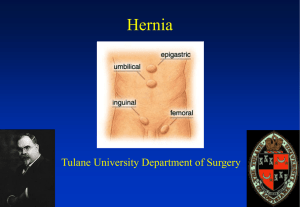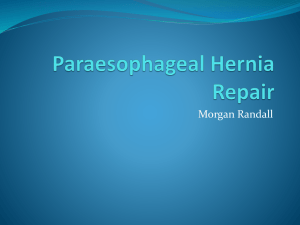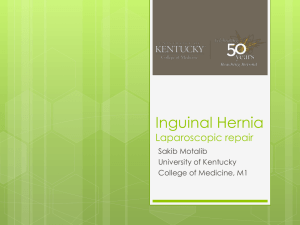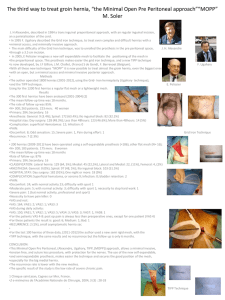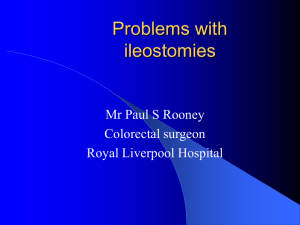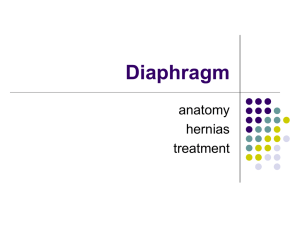Lecture 8 - UMF IASI 2015
advertisement
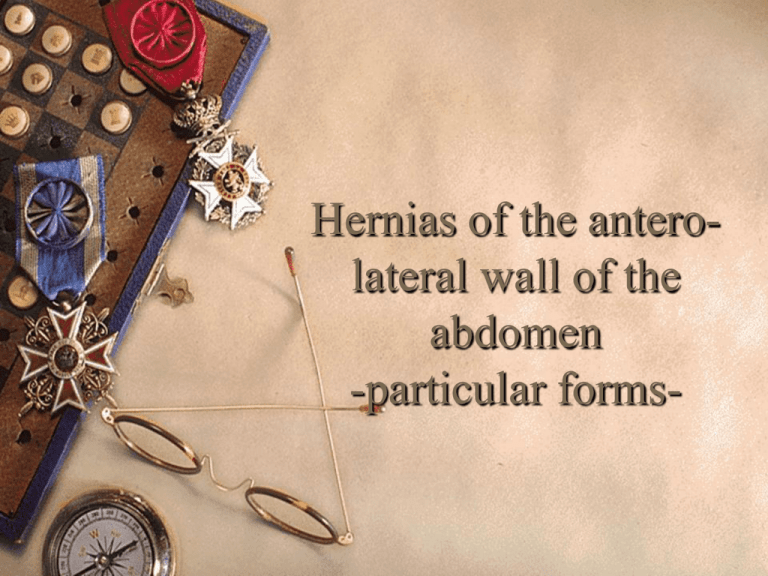
Hernias of the anterolateral wall of the abdomen -particular forms- Inguinal hernias Anatomy briefing Definition: hernias produced through a defect situated on the posterior wall of the inguinal canal Inguinal canal: a space designed for the passage of – Testis – peritoneal diverticula present at birth – Round ligament – peritoneal diverticula present at birth (Nuck) Major opening in the mucsculo-fascial structure of the abdominal wall Inguinal canal Inguinal canal - structure Anatomic structures are dynamic – description represents a schematic view – 4 walls (anterior, posterior, superior and inferior) – 2 orifices: internal and external Anterior wall Fascia of the external oblique muscle Fascia ends in 2 pillars – Spina pubis – Anterior part of pubic bone and rectus sheat Inferior wall Inguinal ligament Concavity opened above Internally – it reflects fibers towards the pectineal ridge = the triangular ligament of Gimbernat and prolonges on the pubic branch of the iliac bone forming one body with the ligament of Cooper – solid strutcture Inferior wall Superior wall Inferior border of internal oblique and transversus : the conjoined ligament Fusion of the structures is NOT the rule The resultant structure is not fibrotic and sometimes very friable – not suitable for suturing Posterior wall Fascia transversalis in it’s way towards the vascular sheat Ligament of Thompson (inferiorly) 2 fibrotic structures ligaments of Henle and Hasselbach Posterior wall Weak anatomic region predisposed to hernia formation Muscular structures are supposed to close the defect during effort Inferior eipgastric vessels separate 3 parts – Profound inguinal orifice (external oblique hernia) – Middle part (medial to the epigastric vessels)– direct inguinal hernia – Internal part (medial to the umbilical artery) inetrnal oblique hernia Orifices Profund (lateral or internal) – Situated in fascia transversalis – the external part – A weak point of the abdominal wall Superficial (medial or external) – Between the pillars of the fascia of the external oblique muscle – The place where a hernia engages towards the scrotum – Place to introduce finger for palpation Content of the inguinal canal Women: round ligament + vessels Men: spermatic cord – cremaster – vas deferens – spermatic artery – deferntial artery – 2 venous plexuses – Nervous branches (ilio-hipogastric, ilioininguinal, genital) Shall we all develop hernia? There is a content passing from the abdomen to scrotum BUT – The trajectory is oblique through muscles and during effort the structures are compressed together – Oblique muscles work as a curtain and close the defect – Internal orrifice is strangulate during effort External oblique inguinal hernia Congenital: persistentce of the peritoneal diverticula through which the testis migrated in scrotum. Frequently associated with abnormal migration of the testis. – Complete form with totaland free comunication from the peritoneum till scrotum – Incomplete forms – vaginala testicularis is separeted +/- hydrocele or cystic remnants in the spermatic cord. External oblique inguinal hernia Acuired : migration of the peritoneal sac – Herniation point – Interstitial hernia – Inguino-pubic hernia – Inguino-scrotal henria Clinical signs Common signs for all hernia Digital exploration through the superficial orifice – Evaluation of the defect – Relations with the epigastric vessels = variety of hernia Differential diagnosis Uncomplicated interstitial hernia – Ectopic testis – Cysts of the spermatic cord – Solid tumors Uncomplicated inguino-pubic hernia – Crural hernia (line of Malgagine) – Lypoma of labia major – Cyst of the Nuck canal Inguino-scrotal hernia – Hydrocel – Varicocel – Testicular tumors Direct inguinal hernia A weak point hernia The area of weakness is the middle inguinal area (between the epigastric artery and remnant of the umbilical artery) Sac is completely separated from the spermatic cord which is pushed away Particularities Frequently in older people, associated with other hernias Frequently bilateral Generally small and do not descend in the scrotum, trajectory being perpendicular on the inguinal ligament. Defect is large – unlikely to produce comlications Differential diagnostic Mostly with the external oblique hernia Age Location Form Trajectory Scrotum Muscular tonus Epigastric arte. Complications Oblique Direct Any Uni/bilateral Pear shape Oblique Yes Normal Internal Frequent Old Bilateral 50% Hemispheric Perpendicular No Weak External Rare Treatment of Inguinal Hernia Objectives: – Resection of the hernia sac – Treatment of the defect – a solid wall to prevent hernia recurrence LARGE VARIETY OF TECHNIQUES Operative principles Incision of superficial structures and isolation of spermatic cord. Isolate the hernia sac and the structure migrated with the peritoneal layer (lipomas) Open the hernia sac Control de content Resction of the sac and suture the peritoneal defect Posterior wall repair GOAL – prevent recurrences “Anatomical” procedures – Behind the spermatic cord (Bassini, Shouldice, McVay) – In front of the spermatic cord (Kimbarowski, Forgue) Procedures that use a synthetic structure (mesh repair) – respect the principle of tension-free repair. Behind the cord repair procedures Mesh repair Laparoscopic mesh repair Orthopedic treatment ONLY when the patient refuses operations or major contraindication for surgical repair Femoral hernia Through the femoral ring in the triangle of Scarpa Femoral ring: – – – – Inguinal ligament (ant) pectineal fascia and ligament of Coopper (post) lig Gimbernat (internal) ileo-pectineal ligament (ext) Anatomy Variants – Herniation point – incomplete (under the cribriform fascia) – complete Prevascular, retrovascular, external Laugier (through the fibers of the ligament of Gimbernat) Femuro-pectineal (under the pectineal fascia) Multi-divericular In combination with inguinal hernia – distension of the groin Higher incidence in women 4x more frequent in women Diameter of the pelvic girdle is larger Accentuated lordosis in lumbar area Pregnancies: weakens the abdominal wall + sustained increase in intraabdominal pressure Pathological particularities Small sac, pear-like, well delimitated neck which is fibrotic DIFFERENCES from other hernia: multiple layers like the onion skins (skin, subcutaneous tissue, cribriform fascia, properitoneal tissue, fascia transversalis) Content: any organ, including caecum, apendix, colon, urinary baldder) Major risk for complications, especially the strangulation – lateral pinch Clinical signs - particularities Few or no functional signs: little pain or heaviness in the groin or during extension of the hip. +/- digestive symptoms (colicky pain, urinary symptoms) more often believed to have another source TYPICALLY the signs indicate and abdominal suffering and the physician does not explore the groin Clinical examination Small pseudo-tumor in the Scarpa triangle , most typical medial to the femoral vessels. INCONSTANT Round or oval shape Prolonged under the inguinal ligament – if the tumor can be felt Frequently obese patients with lare subcutaneous fat layer Clinical examination Consistency is elastic or granular – atypical for a hernia IREDUCIBLE but not associated with a loud symptomatology in the groin IMPULSION AND EXPANSION are either absent or faint High percentage are complicated at presentation Differential diagnosis REDUCIBLE: – Inguinal hernia (line of Malgaigne) – Varicose vein – Aneurism of the superficial femoral artery – Tuberculous (cold) abscess migrated in the Scarpa triangle Differential diagnosis IREDUCIBLE: – Strangulated inguinal – – – – – – hernia Cyst of the canal of Nuck Ectopic testis Lypoma Lymphnode enlargement Venous thrombosis Hematoma Treatment Principles same with all hernia Access: – femoral – inguino-femoral – inguinal Parietal reconstruction: – Closing the femroal ring by suturing the inguinal ligament to Cooper ligament and pectineal fascia – Suturing the conjoined tendon to Cooper ligament – Mesh prosthesis Umbilical hernia A. Congenital Failure in the development of the abdominal wall – Embryonic form (defect appears before the 3rd month and organs are not covered by peritoneum – not real hernia – Fetal form – covered by peritoneum Pathology Translucent covering (displastic wall) without vessels and muscles You can see abdominal viscera through the wall. Content can be as much as the whole abdominal content Clinical aspects Large ventral tumor, present at birth and surrounded by a skin ring Transparent wall: abdominal viscera EVOLUTION: spontaneous rupture + death TRATAMENT: surgical - small defects: as in hernia - large defects: skin flaps +/- serial operations B. Umbilical hernias of the child Causes: – Weak umbilical scar (infection, distension) – High intraabdominal pressure (crying, coughing, fimosis, etc Pathology: – Small sac with a large neck, little chances of strangulation Treatment Conservative: if – Less then 2 years – Less then 2 cm diameter • Has to be maintained reduced via a skin fold until spontaneous closure Surgical: – Resection of the sac – Parietal repair C. Umbilical hernias of the adult Weak point Obese women, multiple pregnancies, chronic peritoneal dyalisis, ascites. Particularities Direct herniation most typically (indirect machanism is possible if the ring is asymmetrically positioned) Sac initially small may become multidiverticular + changes generated by the degenration of the sac by expnasion Rigid neck – strangulation factor Content: most frequent properitoneal fat, but viscus can migrate as well Clinical signs Pain on effort +/- digestive symptoms Typical signs of hernia with a major tendency to become irreducible If palpation of the ring is possible – large, round, rigid defect Complications Strangulation (rigid ring, with rapid progression to necrosis) Progressive enlargement – irreducible and loosing the right to stay in the abdominal cavity Treatment Surgical: – Omfalectomy and treatment of hernia – Techniques that conserve the umbilical scar (subcutaneous dissection) – Plastic surgery Epigastric hernias Particularities Supraumbilical median line Frequent multiple hernias At the crossing of fibers in the linea alba Small, irreducible and containing mostly properitoneal fat One particular form – diastases of the rectus sheat Symptomatic hernia require treatment Ventro-lateral hernia Spiegel Particularities Anatomic: defect in the ventro-lateral abdominal wall where vessels pass subctaneous. (lateral to the rectus sheat) Hernia pushes the fascia of the external oblique muscle (interstitial form) or overpasses is (complete form) Particularities Clinical: pain + abdominal deformity Dg: in interstitial forms sometimes no signs. Positive dg by US scan Rsik of becoming irreducible or strangulated Surgical treatment like any hernia UNUSUAL HERNIA Lumbar hernia Pposterior wall (triangle of J.L. Petit – G. oblique, G. dorsal, iliac bone) or Grynfeld qudrate space (C12 with small dentate muscle, paravertebral muscles, small oblique and lumbar quadrat) – extraperitoneal – paraperitoneal – peritoneal Other forms Obturator Perineal Hiatus Internal Ischiatic Postoperative hernia Generalities HERNIAS = peritoneal diverticulum under the skin + defect developed postraumatic EVISCERATIONS = posttraumatic wall defect without a peritoneal covering Ethiology Posttraumatic or postoperative Causes that favor postoperative hernia Old age – scaring abnormalities Co-morbidities (liver cirrhosis, cancer diabetes) Obesity Type of incision Postoperative infection Increased intraabdominal pressure developed postoperative – Not adequate suture material – – – – – – Pathology Abdominal wall defect – variable in diameter, frequently multiple, situated under the skin scar Hernia sac: thickened peritoneum, multidiverticular, frequently under the skin in contact with it Visceral content Clinical examination Pseudo-tumor with all characters of hernia Related with the scar Diemension and number of parietal defects Reducible or irreducible Skin overlaying the hernia Treatment Evisceration: urgent, viscus should be placed back in the abdomen and skin should be closed Postoperative hernia: complex treatment preferably elective
